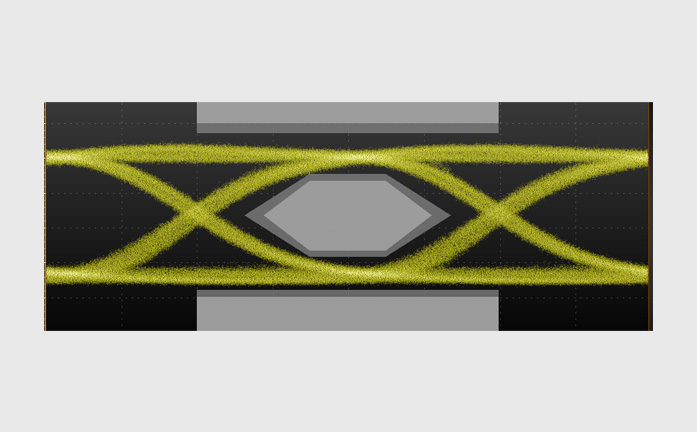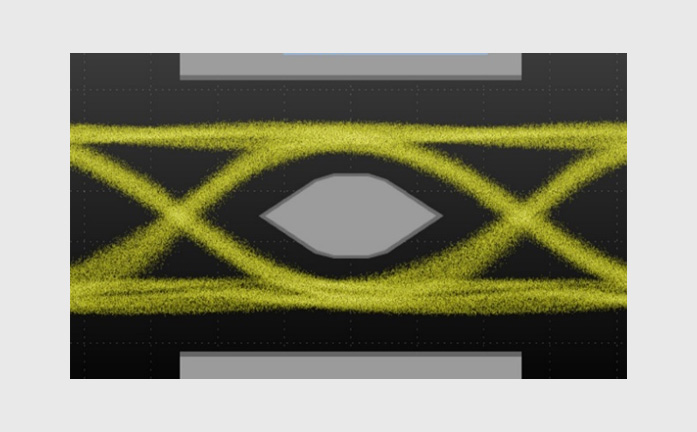
Sampling Oscilloscope
DCA4201
10GHz Sampling Oscilloscope DCA4201
DCA4201 is a sampling oscilloscope, which is designed based on equivalent-time sampling and eye diagram reconstruction technology, it offers a low-cost solution for high-precision measurement of high-speed optoelectronic digital signals.
Features

Fast Sampling
Fast sampling rate 100K
Extinction ratio correction
Support extinction ratio correction
Eye Mask Test
Automatic eye margin testing(Mask Margin)
Standard Filter
Covers 1-12.5 Gbps data ratesFeatures and Benefits

Multi-port integrated design
Small size( about ¼ of traditional sampling oscilloscope), greatly reduces required space.
Calibrated reference receiver
Meets industry frequency response tolerances
Calibrated reference receiver
Semight DCA4201 sampling oscilloscope(10G)With extinction ratio correction factor/dark current self-calibration and other algorithms,
| Module under test |
RMS Jitter (ps) |
Intersection Crossing (%) |
Rise Time 20%~80% (ps) |
Extinction Ratio (dB) |
Template margin Mask Margin (%) |
|
| DUT1 | Semight DCA4201 | 11.69 | 52.04% | 153.86 | 10.44 | 28.91% |
| Consistency (absolute deviation) | 0.26 | 0.06% | 2.34 | 0.12 | 1.20% | |
| Consistency (relative deviation %) | 2.27% | -0.12% | -1.50% | -1.14% | 4.37% | |
| DUT2 | Semight DCA4201 | 7.73 | 50.30% | 149.56 | 11.31 | 40.63% |
| Consistency (absolute deviation) |
-0.1 | 0.06% | 2.34 | 0.12 | 1.20% | |
| Consistency (relative deviation %) |
-1.28% | -0.20% | -3.76% | -2.25% | 3.65% |
| Optical Channel Specifications | |
| Wavelength Range | 850~1650 nm |
| Calibrated Wavelengths (OE conversion gains) | 850/1310/1550 nm |
| Filters | |
| DCA4201-140 |
GPON,1.244 Gbps 1Gb Ethernet,1.250 Gbps, CPRI 1.229 Gbps |
| DCA4201-160 |
OC-48/STM-16,2.488 Gbps, 2 Gb Ethernet,2.500 Gbps, CPRI 2.458 Gbps |
| DCA4201-180 |
10Gb Ethernet LX-4,3.125 Gbps, CPRI 3.072 Gbps |
| DCA4201-200 | CPRI 6.144 Gbps,6.25 Gbps |
| DCA4201-100 | OC-192/STM-64,9.953 Gbps, 10Gb Ethernet,10.3125 Gbps, 10×Fibre Channel,10.51875 Gbps, OC-192/STM-64 FEC,10.664 Gbps , OC- 192/STM-64 FEC,10.709 Gbps, 10Gb Ethernet with FEC,11.0957 Gbps, 10×Fibre Channel with FEC,11.317 Gbps |
| Electrical Specifications | |
| Electrical channel bandwidth | 20 GHz (typ.) |
| Rise Time(10%~90%) | 20 ps |
| Max Input Amplitude | <1 V |
| RMS noise | <2 mV (typ.) |
| Electrical Sensitivity | 24 mV |
| Reflection | 10% |
文档下载
 DCA4201 Quick Start Guide_G2
DCA4201 Quick Start Guide_G2  DCA4201 TCP远程控制使用说明
DCA4201 TCP远程控制使用说明 DCA上位机简要使用说明
DCA上位机简要使用说明
Similar recommendation
Service hotline
Follow
Name
Email verfication code
Phone
Password
Confirm Password
e-mail address
Email verification code
New Password
Confirm Password